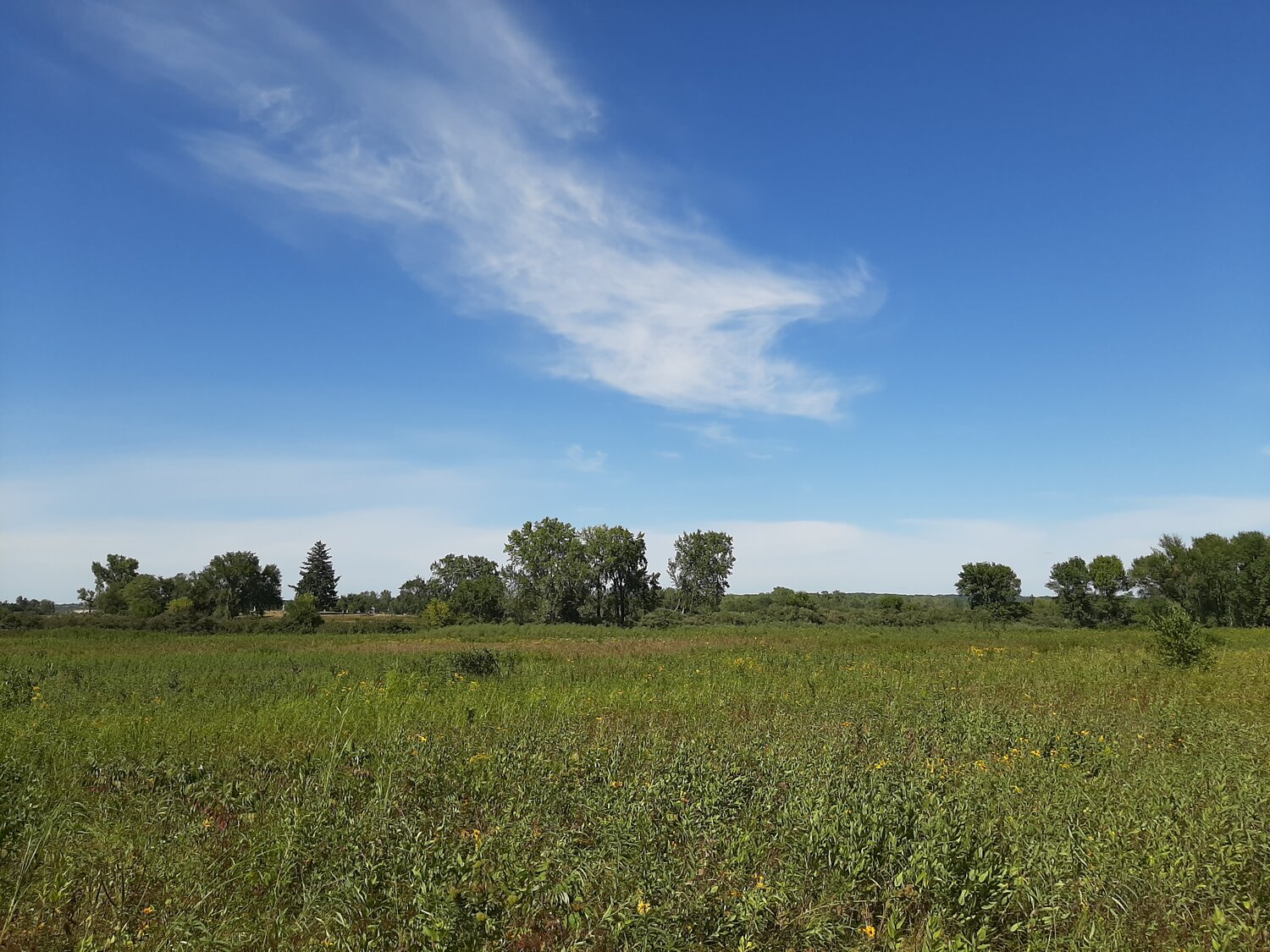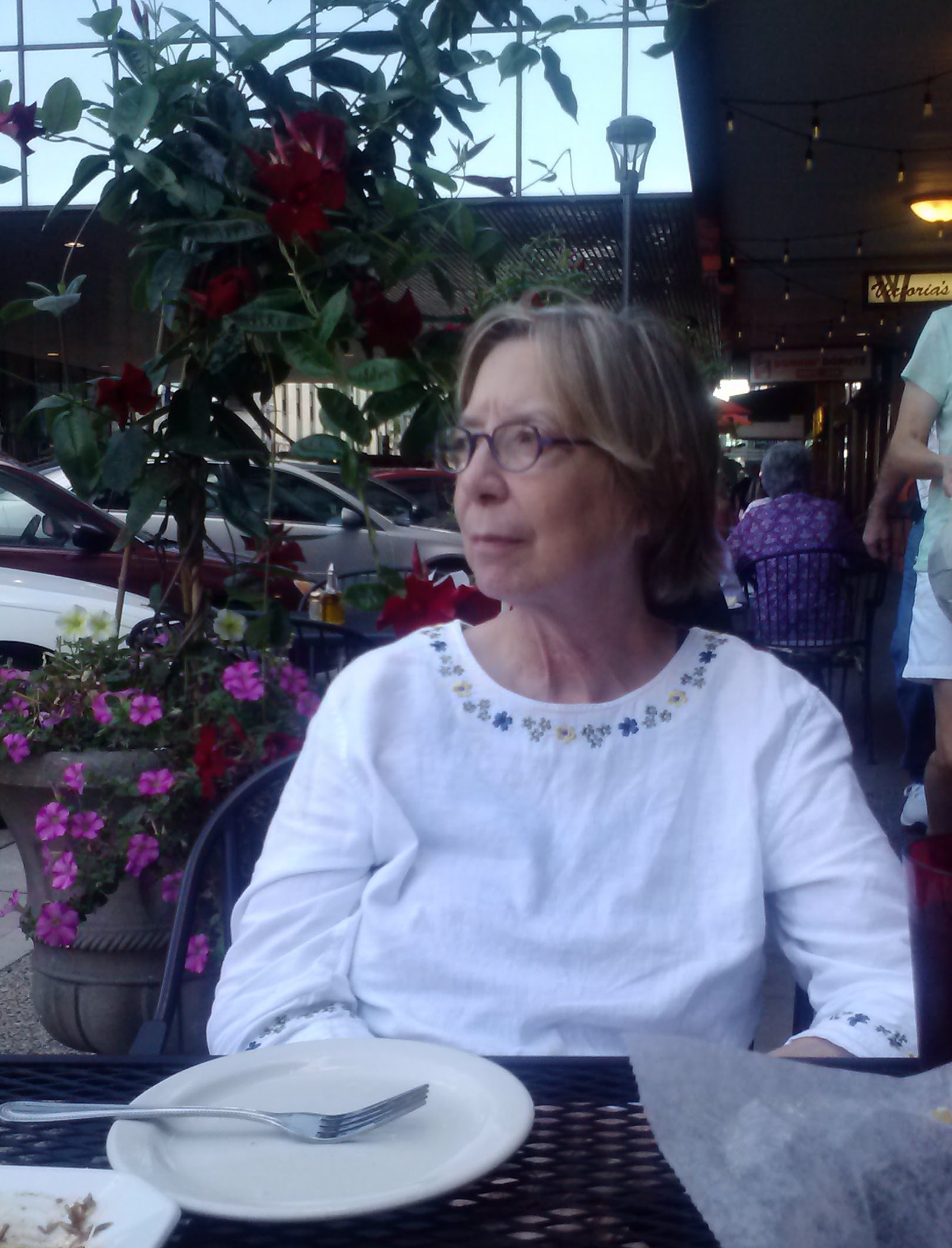Ways To Endure, Part 2
Pat didn’t like having her photo taken. But in 2014, while we were enjoying a dinner before a full day of appointments at the Mayo Clinic in Rochester, MN, I took this candid photo of her. By this point she’d survived five surgeries.
In late June of 2009, two months after being released from the hospital after her emergency open-heart surgery, Pat returned to work. She was the Director of Nursing at Crestview Care Center in West Branch, Iowa, and loved her job. In 1990, after our youngest child, Jesse, started school, she took a job as a Certified Nursing Assistant (CNA) at Crestview, and quickly realized she had an aptitude for and interest in geriatric care. She was a hard worker who never shied away from the more unpleasant and challenging tasks associated with caring for the elderly. She grew close to many of the women she cared for, often coming home with amazing stories about their lives. She also had a thick enough skin to handle male residents who, because of the challenges of adapting to the confinement of age and disability, were often surly, rude, even combative. She treated them with compassion, but could also fend off their cantankerous commentary and throw it back at them, and the men respected her for that.
Crestview’s administrator, Cheryl, was soon encouraging Pat to take advantage of a company benefit that covered the tuition for CNA staff interested in becoming nurses. She enrolled in the nursing program at Kirkwood Community College and began taking classes while continuing to work full-time and care for our family. At the old rambling farmhouse we rented near West Branch, weeknights were study nights. Sierra, in high school, and Emma and Jesse, in elementary school, did their homework, while Pat pored over her Human Anatomy or Pharmacology textbooks.[1] Because my wife was such a good cook, she’d gradually taken over most of the cooking duties, leaving the cleanup to me, but when she started taking night classes, I became the cook, much to the amusement of our kids, who gave me grief that I only made flat foods – pizzas, pancakes, tacos. In my defense, the pizzas and pancakes were made from scratch.
Pat graduated in 1996 with an Associate Degree in Nursing, passing the exam to become a Licensed Practical Nurse. Before long, she was promoted to the Assistant Director of Nursing position, and by 2009 had been Crestview’s Director of Nursing for nearly ten years. She may have gained an office, a desk, and daily paperwork duties, but she still spent much of her time on the floor with the residents, helping the nursing staff, often filling a shift if someone called in sick at the last minute. How many times did we encounter people – while eating out or walking through the Ped Mall – who stopped to thank Pat for how well she had cared for their parent or grandparent.[2] Simply stated, she loved her job.
But at an appointment with her surgeon, Dr. Farivar talked about the unusual state of her cardiovascular system, recommending she undergo genetic testing to see if that might provide an explanation. It did. In July, Pat was told she had a newly discovered connective tissue disorder known as Loeys-Dietz Syndrome (LDS). The disorder had been identified in 2005 by Dr. Bart Loeys of Ghent University Hospital in Belgium and Dr. Harry Dietz of Johns Hopkins University School of Medicine, whose findings had been presented in an article they co-wrote and published in Gene Reviews journal just one year before Pat’s surgery.
Similar to the more widely known Marfan Syndrome, Loeys-Dietz Syndrome is characterized by aggressive cerebral, thoracic, and abdominal arterial aneurysms and dissections.[3] Because of this, the average lifespan of LDS patients is 26 years and women with LDS have a high incidence of pregnancy-related complications, including uterine rupture and death, all which made Pat, a 56-year-old woman who had given birth to three children, an extremely rare case. Some of my wife’s features that made her interesting and endearing to me – her velvety and translucent skin, her wide-spaced eyes, the hyperflexibility of her joints – now helped confirm the LDS diagnosis. More importantly, the diagnosis raised the question of whether she’d be able to continue working.
In early August, at a follow-up appointment with Dr. Farivar, a CT scan revealed a dissection of Pat’s descending aorta. He immediately scheduled a second surgery and urged her to go on disability. Cheryl sat down with her and persuaded her that this was the best course of action. Pat did not want to leave the job that she loved, that gave her life purpose. (We often talked about how, in the middle of our lives, we’d both found paths to professions – nursing the elderly, teaching teenagers – that felt meaningful and important to us.) It didn’t help that the decision to stop working had to be made quickly to verify the disability so she could qualify for full long-term benefits. Even considering all the cardiothoracic surgeries she would undergo over the years, this forced retirement hurt her heart more than anything else.
During those days, Pat and I would each climb aboard our own runaway trains of thought. For her, the fact that LDS was now part of her body and life, something perhaps treatable but never curable, seemed patently unfair. She had taken care of her body, paying careful attention to what she put into it, shunning chemically processed foods for homegrown and organic produce and meat. She couldn’t let go of the randomness and injustice of it all. I’d try to offer the perspective that illnesses aren’t handed out on the basis of some moral calculation. If we could agree that no one deserves to be ill, correspondingly no one’s earned the right to be healthy. But in light of all Pat was facing, it was hard for her to be philosophical.
I was vexed by my own emotional and illogical distractions. A stitch in my side while jogging became a harbinger of a heart attack. A bout of indigestion might be the first symptom of a stomach or colon cancer brewing inside me. This focus on the slender and unraveling rope of my mortality would be momentary, but I often had a hard time shaking it. I mean, who knew? Pat was perfectly fine that April morning in 2009 when I kissed her goodbye, neither of us aware of those cardiothoracic booby traps ready to explode. By the end of that day, she was clinging to life on an operating table. I kept these spells of death anxiety to myself. Given what Pat was going though, it didn’t feel right troubling her with them.
However, the situation of our 24-year-old son, Jesse, occupied both our minds. Before moving home after the first surgery in April, he had been living and working in New York City as a sous chef. Bit by bit, we began to learn how badly he had been scuffling there, never holding down a job for long, squatting in an empty warehouse in Brooklyn, developing an unhealthy relationship with alcohol, an occupational hazard in the high-stress restaurant industry. After the surgery he found a good chef job in Iowa City, and we held out hope for a turnaround. Jesse is a sweet man, and we were happy to have him around. But his alcoholism was slowly becoming apparent, as much as he tried to hide it from us. His sunny disposition would get lost in a fifth of gin, and our growing concern for him pushed the impending surgery into the background.
Even with all that seemed to be hanging over our heads, Pat and I were grateful for my school break and the time we had together that summer. Not that I ever stopped thinking about teaching, but in those months I could stay home with her while updating my curriculum and fine-tuning my courses. We’d take Auggie, our Aussie–border collie mix, for long walks around the neighborhood. In the evenings we’d binge-watch TV shows, mostly police procedurals – Law & Order and CSI: Las Vegas, Prime Suspect and The Closer because we liked strong female characters, Criminal Minds and Dexter because we liked our stories dark, Sherlock and House because Pat was fond of Benedict Cumberbatch and Hugh Laurie, both of whom looked a lot like her father.
The surgery to repair the descending aortic aneurysm took place on September 3, 2009. I knew I’d be taking some time off early in the school year, so I made an extra effort to build a good rapport with my students in that first week and made sure I got the best sub available. I spoke frankly with my students about why I’d be gone, reminding them that although I was committed to being their teacher, I had equally important personal commitments. As was true after the first surgery, my students displayed a surprisingly deep reservoir of empathy. That fall, both before and after the second surgery, students from the previous year would often stop by my classroom or catch me in the hallway to ask how my wife was doing.
I told my students the surgery was risky, but I tried not to let on how worried I was about it, neither to them nor to Pat. I’ll never know how she was able to manage the anxiety she must have been feeling, but as I’ve said before, she possessed remarkable inner strength.
For this second surgery, Dr. Farivar had a better sense of what he was walking into. His surgical team included seven assisting doctors, eight nurses, and two perfusionists. Even with all that help, the surgery took ten hours. Pat was kept in the ICU for four days and sent home ten days later. The surgical outcome was positive except for one complication – some injury (perhaps during intubation) had paralyzed her left vocal cord. An otolaryngologist’s attempt to repair the vocal cord with an injection proved ineffectual. All that was left was a raspy whisper. She would never again speak to me in her normal voice.
For years, I kept a voicemail from her on my phone so I could hear that voice. It didn’t matter that she was chewing me out because of my bad habit of not answering her calls – I’d muted my phone, or forgotten to charge it, or left it on my desk while I made copies – and that her message was particularly salty. It was still good to hear from her.
Footnotes
[1] Sierra has told me, “I vividly remember the intensity of her study habits. She started every session with the assumption that she couldn’t do it, but her notes and review processes were amazing. This stands out to me because as a ‘gifted kid,’ I never had a fraction of her determination and perseverance.”
[2] In 2002 Pat was nominated by Cheryl for the Director of Nursing of the Year award given by Care Initiatives, Crestview’s parent company.
[3] That is, abnormal swellings in the wall of an artery or tears along the inner lining of an artery, weak spots susceptible to sudden ruptures causing massive internal bleeding.

